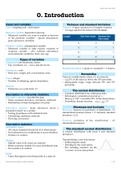Summary
Summary Advanced biological data analysis theory and codes
- Course
- Institution
This summary contains the theory given in the lectures and the codes used in the practical sessions. Since notes are allowed on the examen, this is al the information needed to answer the questions.
[Show more]



